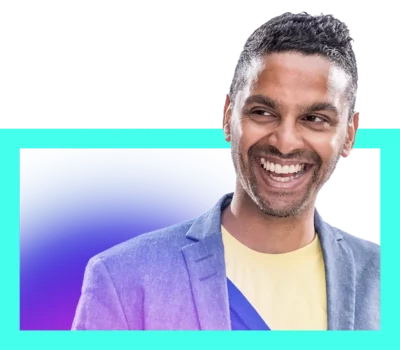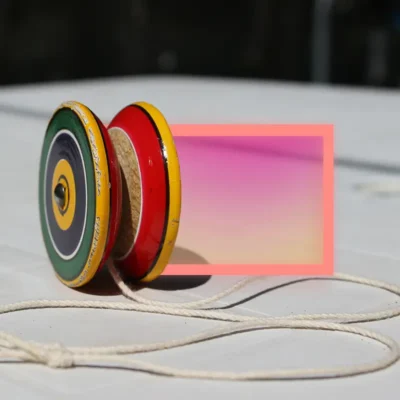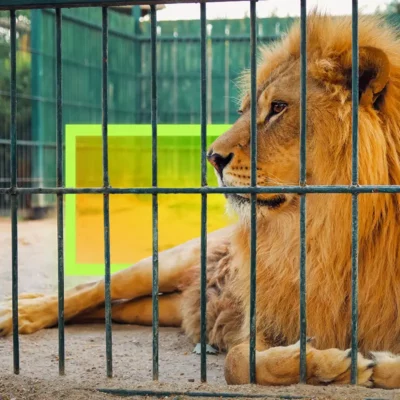Embrace every part of yourself
Tech entrepreneur and author of Everyday Dharma, Suneel Gupta spends much of his life feeling divided between his Indian and American identities. His desire to fit in with his peers forces him to hide parts of himself and turn away from his true purpose. In this episode, Suneel tells the story of how he finally learns to welcome all parts of himself and stand proud in everything that he is.
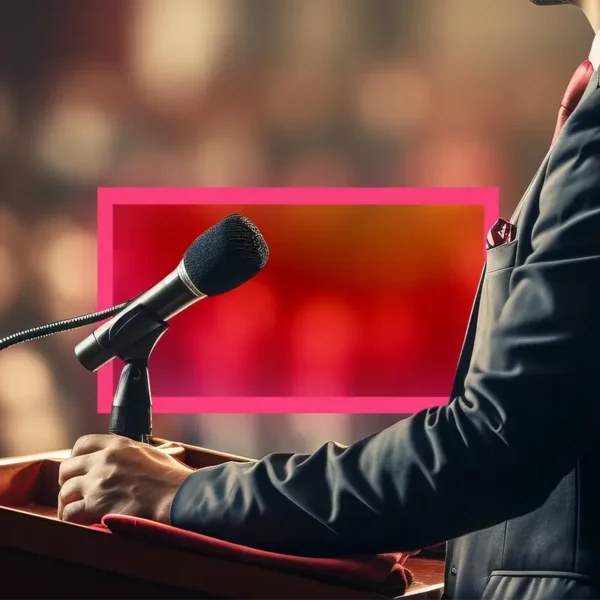
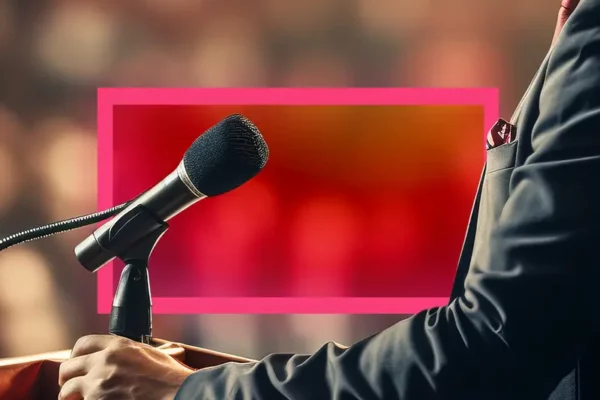
Table of Contents:
Transcript:
Embrace every part of yourself
SUNEEL GUPTA: I walk through the big wooden door carved with Hindu mosaics. So much has changed about the temple, but there are special little things that remain the same. My shoes rest in the same cubby hole I used as a kid, and my bare feet walk quietly on the cold marble floor. I lower myself onto the ground of the prayer hall, and sit cross-legged on the carpet. I remember its fragrance. For the first time in decades, I close my eyes and pray.
ROHAN GUNATILLAKE: Growing up in suburban Michigan, Suneel Gupta, author of Everyday Dharma, feels as though his life is divided between two realities: that of the Indian boy and that of the American child. It’s not until years later, after a surprising career pivot to politics, that Suneel learns it is possible to embrace all parts of himself and that he is stronger when he does so.
In this series, we combine immersive first-person stories, breathtaking music, and mindfulness prompts so that we may see our lives reflected back to us in other people’s stories. And that can lead to improvements in our own inner lives.
From WaitWhat, this is Meditative Story. I’m Rohan, and I’ll be your guide.
The body relaxed. The body breathing. Your senses open, your mind open, meeting the world.
GUPTA: I sit, cross-legged, on the floor inside my temple. Statues and paintings of deities surround me. The smell of incense, jasmine, and garland in the prayer hall mixes with cardamom, potatoes, and cauliflower cooking in the back kitchen. If I focus, I can hear aunties preparing food and slicing open fruit. Their soft chatter contrasts with the loud beating of my heart.
Next to me is Sastry, our young and energetic priest. We are seated at the front of the temple, facing hundreds of people, who all have their expectant eyes on me. Sastry gives me a nod to begin. I take a breath to steady myself.
I’m 8 years old, and I’m about to sing a bhajan — a devotional song that Sastry helped me learn. I don’t understand most of the Sanskrit words. But I’m good at memorizing. My voice floats out in invitation. After each line, Sastry and every other person in the hall chorus it back to me. Like a game of ping pong, we go back and forth, call and response. The bhajan builds to a crescendo. Bells begin to ring, a conch horn sounds, the crowd sways soulfully from side to side.
I feel alive. Connected. I don’t want this song to end. For these few minutes, I feel like a Hindu Bruce Springsteen. A rock star.
When the service ends, we shuffle out of the prayer hall into the cold of a Michigan winter. I pass through the big wooden door, carved with mosaics and inscriptions that crawl up the solid teak wood.
That temple door is a divider between my two worlds. Inside this building, I am an Indian child, one who craves his parents’ approval and knows he has it when I’m singing bhajans. I am one of the select few who Sastry chooses to perform by his side. I take a lot of pride in that.
As soon as the heavy temple door swings open, though, I am an American boy. One who desperately wants to fit in. My skin color makes that difficult.
My family and I live in a lily-white suburb of Detroit. The ‘90s have begun, and with it, the first Iraq War, “Operation Desert Storm.” More than a few students in my school have brothers and fathers fighting in the Middle East.
Jason Weber is one of them, and he seems to believe it’s his patriotic duty to beat up on the brown kid. I run from Jason and his friends in the hallways, but they always catch me. They want me to understand that I don’t belong.
I do what I can to blend in. I cake baby powder onto my face to seem whiter. I overwear t-shirts featuring the most iconic American I can imagine, Bruce Springsteen. I pretend it doesn’t bother me when other students call me a “camel jockey” or tell me they “don’t like my kind.” And I certainly never talk to anyone about bhajans or anything Indian. I’m convinced that if the outside world finds out about my inside world, acceptance will be impossible.
“Suneel, what are you thinking of doing next year?” I look up.
I’m in the atrium at the Northwestern University School of Law. And I’m studying for finals. Dark gray carpet and black leather chairs yield to off-white stone walls. Far above, metal beams criss-cross huge panes of glass that welcome what’s left of the day’s light. The distinct smell of giant textbooks fills the air. Seven of us sit at a long, rectangular table in the open section of the atrium.
We’ve been here for hours. Papers are spread everywhere. We grind through case briefs. Switch between heads-down focus, quizzing one another, and taking breaks to goof off. But conversations amongst third-year law students always find their way back to the big and obvious question.
This time, it’s my friend Alex who asks: “Seriously, what are you thinking of doing after we graduate?”
We’re all at the age when we should have a plan for the future. Or at least that next step. But it’s not so cut and dry for me.
Before law school, I work for the Democratic National Committee. I travel up and down the country, writing speeches for political candidates, from those running for the U.S. Senate to potential captains of local precincts. It’s not glamorous, but I actually don’t mind the crappy motel rooms, the constant bus travel, the urgency, the sleeplessness. I love writing speeches because of how it connects me back to who I feel I really am.
I remember being in social studies class in 7th grade, learning about Martin Luther King Jr. and his ‘I Have A Dream’ speech. We watch it together on a boxy little TV. Then, my teacher pulls up a luminescent image of Dr. King on the slide projector. He stands in his office, arms crossed.
On the wall behind him is a framed photo of Mahatma Gandhi. I squint to make sure what I’m seeing is real. Gandhi is a huge figure within my family, but he’s never been mentioned inside my classroom.
I’m stunned. Everybody recognizes Dr. King as a hero, and his hero is Gandhi.
For that moment, my two identities — Indian child and American boy — aren’t in battle; they’re in harmony. A little voice inside of me whispers “It’s okay, you don’t have to be ashamed anymore. You can be proud of who you are.”
My teacher then mentions that both Dr. King and Gandhi sometimes worked with writers to craft their speeches. It’s the first time I hear the word “speechwriter,” and I decide then and there that this is what I want to do for the rest of my life.
Every day after school, I come home to practice writing speeches for great leaders — living or dead, it doesn’t matter. As the years pass, I write speeches for friends, family members, classmates. For birthdays, weddings, and bar mitzvahs. I write a Diwali celebration speech for my uncle, an anniversary speech for my cousin, a retirement speech for my Dad. I don’t graduate valedictorian, but I write the speech for the guy who does.
With each draft, I become a little more confident. I start to make more friends. I come out of my shell a little bit more. I feel like these speeches are my calling. Or what Sastry would say is my dharma. And I start to think that one day, I’ll be the guy standing at the podium, delivering my own words to a crowd.
I go to law school with every intention of pursuing that dream of running for public office, but the closer I get to graduation, the more I begin to doubt my dream. So, I turn Alex’s question back to him.
“Well, what are you doing next year?”
He doesn’t hesitate. He says, “I’m going to Silicon Valley.”
Around the table, everyone nods at this mention of America’s center of wealth and innovation. I’m not surprised. It’s 2007. Apple just released a device called the iPhone, the biggest thing since the personal computer. All the smart and ambitious people I know seem to be heading to the Bay Area to work for big tech firms or to start their own. All of them have dreams of becoming the next millionaire or even billionaire. There’s an excitement in their voices when they talk about it. And that excitement is contagious.
I feel torn between two worlds — one I know I love and another I’m afraid to miss. One that feels like a marriage of my two identities. And one that does not.
I play out both scenarios in my head… Running for public office means moving back to Michigan and convincing the same people who rejected me and bullied me to vote for me. Silicon Valley, on the other hand, feels safe. It’s filled with successful people who look just like me.
So I run away from my childhood dream, and away from myself. “Me too,” I tell Alex. “I’m going to Silicon Valley.”
GUNATILLAKE: Does a time come to mind when you made a pivotal, sliding doors-type decision? Turning away from one version of yourself for another. How does it feel reflecting back on it? What thoughts bubble up? Let them come, and let them go.
GUPTA: My wife, two daughters, and I are on a plane back to San Francisco after a weekend in Baltimore with Leena’s parents. I’m in the window seat. Outside, sunlight reflects off the stark white clouds. I rub my eyes and move my fingers to my temples.
I’m 37. And I’m exhausted. I’ve been in Silicon Valley for nearly a decade, working hard for other companies and eventually building my own. It’s been a high-stress existence, and the pressure has taken a toll. I thought that having some success would help me find myself. It hasn’t. I feel more lost than ever before.
With a sigh, I fish my phone out of my pocket and scroll through an endless feed of noise to quiet my mind. When I refresh, I see a “BREAKING NEWS” post. Then another. There’s a violent rally happening in Charlottesville.
Police cars in the background. Officers in riot gear. People have been injured, even killed.
I scroll faster, until my finger floats over the hateful image of a Confederate flag. My jaw tightens. My foot taps. I click on a video and wait for the plane’s WiFi to catch up.
White supremacists walk through the streets of Charlottesville, Virginia. They carry Confederate flags and flaming tiki torches while reciting hateful chants.
I feel myself tear up. The marchers are so far away. But it feels like they’re in the airplane row right behind me. They don’t look like strangers either. When I pause one of the clips, I feel like I’m seeing some of the faces of the people I grew up with. Of Jason Weber and his friends chasing me through the halls, body-checking me into the lockers. The same guys who would tell me to “go back to Iraq, back to Saddam.” Who don’t care how much I hide or assimilate because I will never be white enough.
I’m angry and afraid. Is this the beginning of something? Are we about to see this everywhere? I reach for my wife’s hand and squeeze it tightly. I look at my newborn daughter who is fast asleep in her arms and her older sister who is coloring on the back of a napkin. The sunlight from the window shines brightly on their beautiful brown skin.
And suddenly, I feel ashamed. Ashamed for all the years I tried to hide who I was, to conceal my Indian-ness, to pretend I’m something that I’m not. How will I ever explain that to my girls? How can I show them what’s it like to be proud of who you are?
I realize the best thing that can happen for these guys in Charlottesville is for someone like me to stay in Silicon Valley. Out of the picture. But my future, my family’s future, never feels more tenuous than it does right now. So I decide that I’m done running away from who I am or what I’ve wanted all along. No more trying to be someone or something else. No more hiding.
Behind a portable wooden podium, my shoes sink into the stale, musty carpet. The audience is seated at small, circular wooden tables that move around on wheels. A long picnic table hosts a collection of snacks. Two liter bottles of Diet Coke and Mountain Dew. Paper cups and plastic plates. An open bag of Doritos hangs precariously close to the edge.
It’s 2018. I’m back in my hometown, a suburb just outside of Detroit. And I’m about to make one of the first speeches in my campaign for the U.S. House of Representatives. I’m the only one in a suit. I’m in a public library. Everyone else is in jeans. Why am I wearing this suit? I’ve just spent the past 20 minutes trying to convince these voters that I understand their worries. That I’m from here, that I’m one of them. Everyone is calm despite the charged political climate in the country. No one shouts. I just hope it will stay that way during the Q&A session.
One woman asks about funding for schools. Someone else asks about healthcare. Then a man in the audience stands, stares at me point blank, and asks: “Why do you think that someone with your skin color can win in a place that has never elected someone who isn’t white?”
I feel caught off guard by the bluntness of the question. I know others are probably wondering the same thing, but I don’t expect anyone to ask it out loud. I’m certainly not in San Francisco anymore.
He continues, “Look, I’m not racist, you know, but my next door neighbor is. Do you really think you have a chance?” I know exactly the kind of neighbor he’s talking about. Throughout this campaign, I knock on the doors of houses I avoided as a kid. I come face to face with bullies who used to torment me. Some slam a door in my face. Others tell me to go back to my own country. But, really, most people are kind or at least decent.
Looking around this room, I see those same decent people nodding their heads at this question. Everyone is waiting for my answer.
I pause to think. Do I deflect? I could skirt past the issue. Diminish its importance. But, that doesn’t feel honest to how I’m feeling. Or how anyone in this room is feeling. I remind myself: no more hiding. My reply starts slowly. Tenuously.
“You’re right. I’m not white. And that will make this race tougher.” I take a breath and continue. “But I’m here now because someone with my skin color has never been elected in this district. It’s time for that to change.”
I see shoulders in the room relax, and mine do too. If the thing on everybody’s mind is my race and identity, well, good. Because that’s the thing on my mind as well. Now I have permission to talk about it. To fully share my story of who I am, and why I’m running.
I pick up momentum. My confidence builds. As I speak, I feel the divider between Indian child and American boy, that wall I’ve put up for so many years, start to come down. And that feels really good.
I’m meeting these people where they are, and they are meeting me — the real me. The full me.
With every speech and every door knock, a voice inside reminds me not to hide the parts of myself that are different. That I don’t need to choose between identities. That it is possible to both stand out and fit in.
GUNATILLAKE: There is a real beauty here, one which comes with Suneel’s realization so wonderfully put. Breathing, let’s enjoy it, feeling the fullness of the breath, the fullness of ourselves.
GUPTA: I walk through the big wooden door carved with Hindu mosaics. So much has changed about the temple, but there are special little things that remain the same. My shoes rest in the same cubby hole I used as a kid, and my bare feet walk quietly on the cold marble floor.
I lower myself onto the ground of the prayer hall, and sit cross-legged on the carpet. I remember its fragrance. I’m alone. My daughters are in another room for a dance class. For the first time in decades, I close my eyes and pray.
I lost the election. Yesterday I went to my campaign office for the last time. The walls are now bare, the seats are empty.
There are only a few boxes of Gupta for Congress t-shirts and glossy buttons that now sit in the trunk of my car. Artifacts of a campaign that is now over.
I sit here in the temple and ask, “What now? What next?” I’m praying for an answer.
With eyes closed, the sounds of my bhajan days are coming back to me: tiny bells, aunties chattering as they prepare spiced aromatic dishes. And then one sound soars above the others. A deep and rich “Ommmmm.’’ It’s a voice I recognize instantly. And when I open my eyes, there he is… Sastry, the priest from my childhood. It has been nearly 20 years, but he still looks the same, still smiling, still dressed in the same saffron-colored robe I remember. We embrace, and then we sit in the same spot where I used to sing by his side.
I tell Sastry my story. How, for too long, I pursued a path that didn’t feel like my own. How I ran away from who I was. How I came here to change all of that, to come back to my dharma, my inner calling. I barely get the words out before emotion gets the best of me. I remember how good it felt to sing bhajans with Sastry, to have him see something in me, to be proud of me. But now, I’m shamefully admitting to him that I lost. That I failed.
Sastry sits with me in silence for what feels like an eternity. Then, finally, he turns to me and says, “Suneel, it is always better to fail at your own dharma than to succeed at someone else’s.”
There’s a sound at the back of the prayer hall. Our heads turn to see my daughters, Sammy and Serena, sprinting towards me in their colorful salwar kameez. They look like they’re dressed for an Indian wedding. They could have worn jeans to dance class if they wanted. But they love the feel of these clothes and the ornaments that come with them. They are truly proud of who they are. And watching them, I’m proud of who I am too.
Inside that temple, my daughters watch me re-engage with my culture. They see my relationship with Sastry begin to grow once again. They watch me reconnect with aunties and uncles from my past, and hear stories about how their father would sing bhajans for everyone here.
When we leave that day, me holding each of my daughter’s tiny little hands, I finally feel a sense of belonging on both sides of that temple door.
Each of us is many parts wrapped into one. I am a temple singer, a speechwriter, a tech founder, a political candidate, an author, a father and a husband, an Indian, an American.
Sometimes these parts don’t fit together perfectly, but they all have a place inside. My Indian-ness, my American-ness. The person who wins, the person who loses. The part of me who feels anger and disappointment, fulfillment and joy. The part of me that wants to stand out, and the part of me that wants to fit in. And as time passes, I take little moments to quietly say out loud: “May all parts be welcome.”
Rohan’s closing meditation
GUNATILLAKE: Thank you, Suneel.
As the kid of two parents who emigrated from Sri Lanka to London back in the late ‘60s, I recognize a lot of what Suneel has spoken about here. The joys and the challenges. And the story has got me thinking — thinking about collapse. Suneel had kept different parts of his life, different parts of his identity separate, and there was a real value to that for him at the time. But when he was able to collapse that separation, that was when there was maybe a greater value, certainly a deeper contentment. A release.
This concept — i.e. of exploring what happens when we poke holes in the boundaries between things, when we test just how real and solid they actually are — is totally pivotal in the mindfulness tradition. It’s a reminder that although it may seem counterintuitive, we are actually stronger without those walls up. Suneel covered this concept one way, and in our meditation together now let’s do it another way.
Like many meditation techniques, a good place to start is with the body.
When we talk about body awareness, we mean dropping our attention, as much as we can, into our physical sensations. And when we do that it can help to pay attention in turn to different parts of the body.
For example, right now let’s pay attention to how our hands feel. If it’s ok and safe to do so, let’s close our eyes for the rest of the episode.
Now, from the hands, move your attention to your feet. Feeling the sensations here in the feet. Notice how we know the difference, know how to target this particular part of the body, and know the sensations here.
Now, from the feet, being aware of the rest of your leg. The lower leg and the upper leg. Again, noticing how you can easily make that distinction.
We do make these distinctions. If you’re able to put one hand in the other interlocking the fingers, here we can feel our left hand and feel our right hand. And we can feel the places where our left hand and our right hand meet.
But, can we get interested in whether that is really true? Where do the sensations of the left hand start and those of the right begin? I’m not saying there is a right answer to this; what I’m trying to do is point you into curiosity, into inquiry.
What happens if we collapse the idea of a left hand and a right hand. What remains? What is here in our direct experience?
What if instead of framing our body as this part and that part, what is it like to know the body as a whole?
The body as a unified field of experience? Nothing separate.
What if instead of considering our body and our mind different, what is it like to know the bodymind as a whole. Everything included in what we are. No distinctions. No separations. Everything welcome.
Thank you Suneel for reminding us of the freedom that can arise when we allow boundaries to collapse.
And thank you. Go well.
We’d love to hear your personal reflections from Suneel’s episode. How did you relate to his story? You can find us on all your social media platforms through our handle @MeditativeStory, or you can email us at: [email protected].
